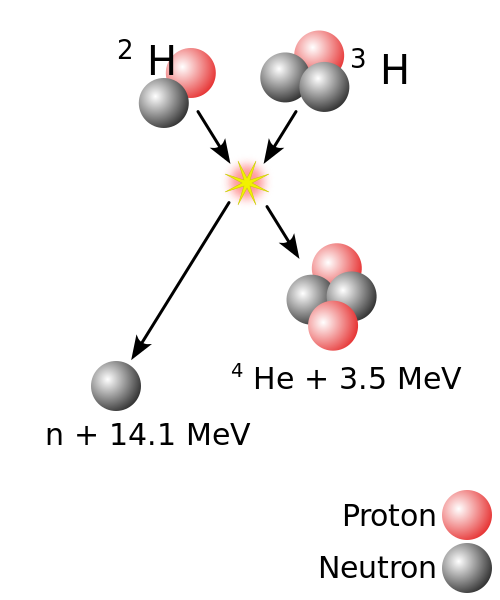In the last few weeks, there have been a ton of headlines about a “breakthrough” in nuclear fusion technology, with some writers breathlessly hailing this as a cure for climate change and pollution. In theory, it can be. In reality, this breakthrough is checking the first box of many, many, many boxes that have to be checked before a viable fusion reactor can exist. Here’s what you need to know.

WHAT ACTUALLY HAPPENED AT NIF?
The fusion development in question happened at the National Ignition Facility (NIF) at the Lawrence Livermore National Laboratory, which has been trying to accomplish exactly this for a few decades now. The short version is that they managed to use a tremendous amount of energy to trigger a fusion reaction, which released an even tremendouser amount of energy. This is known as “ignition” (The “I” in “NIF”) and is the first step towards a proof of concept of making an actual fusion generator. But let’s take a step back.
HOW DOES FUSION WORK?
The basic idea of fusion is simple: if you take two atoms and push them together, they resist. If you push them together hard enough to overcome that resistance, they form a new atom and all that resistance is released as energy. Like this:

The numbers in “MeV” are referring to “mega electron volts,” which are a unit of energy used on an atomic scale. The 2H and 3H at the top are referring to deuterium and tritium, which are hydrogen atoms with one and two extra neutrons, respectively. The 4He is helium and the stray n is an extra neutron.
It sounds complicated, but fusion energy is surprisingly simple. Crash certain atoms together with enough force, and it just happens. We know that this is how it works because that’s what our Sun has been doing for billions of years. Every second, the Sun turns 600 million tons of hydrogen into 596 million tons of helium, and the remaining 4 million tons of matter becomes energy.
A lot of that energy goes into powering more fusion. It’s a self-sustaining reaction, as long as you don’t run out of hydrogen.
In the Sun, hydrogen is fused to create helium, which is then fused to create lithium, beryllium, boron, and so on and so on through the first 26 elements of the periodic table up to iron. Fusing silicon into iron actually consumes more energy than it emits, so when a star starts to fuse iron, it rapidly dies. That rapid death leads (in some cases) to supernovae, and the enormous amount of energy present in a supernova is what creates all the other elements that exist. That’s one of the reasons we know that our solar system is much younger than the rest of the Universe, incidentally — the fact that we have elements heavier than iron means that a bunch of stars must have gone supernova before our solar system existed.

OK, BUT HOW DOES FUSION WORK ON EARTH?
Fair question. The Sun and other stars have kicked off fusion naturally by being huge. Because the Sun is huge, the pressure at the center of it due to gravity is enough to ignite a fusion reaction. If Jupiter were a lot bigger, it could have turned into a star as well.
But we can’t rely on gravity here on Earth, because we can’t gather enough matter into one place to simulate the Sun. Instead, we rely on heat.
On a molecular and atomic level, heat is just motion. The hotter something gets, the faster the molecules and atoms that constitute it are moving, bouncing back and forth off each other. If you get hydrogen hot enough, the atoms crash into each other with enough force to fuse. Once fusion is achieved, presumably we’d use the excess heat to power steam turbines or something and voila: infinite clean energy.
That leads to two more problems: first, how do you get it that hot? And second, how do you contain hydrogen at temperatures of one hundred million degrees?
Inertial confinement vs magnetic confinement
There are two main approaches to these problems. The first, magnetic confinement, uses something called a tokamak, which is a Russian abbreviation referring to a donut-shaped chamber with magnetic coils.

In principle, you’d fill the chamber with deuterium and tritium, heat it up to the point of fusion, and then use the magnetic fields generated in the walls of the chamber to keep the superhot fusion from melting the whole thing (the magnetic fields also do the heating). The heat generated from the fusion would then create a chain reaction that kept fusion going, making a self-sustaining generator (as long as it had fuel).
In practice, thanks to some very complicated quirks of how powerful magnetic fields, no one’s been able to achieve ignition this way. It’s a solvable problem, but certainly not an easy one.
The second version is “inertial confinement,” which is a fancy way to say “heat it up so fast that it can’t expand before it fuses.” This involves filling a little plastic globe the size of a pea with deuterium and tritium, then wrapping that in a gold pellet about the size of a mini marshmallow, then shooting the gold pellet with 192 colossal fucking lasers. The gold gets superheated almost instantly, heating the fuel inside while simultaneously not letting it escape, and fusion is achieved.

This is the method that NIF uses and it’s the method that was successful a few weeks ago.
Now that you’re caught up on how all this works, let’s talk about the problems. Starting with colossal fucking lasers because they’re cool.
COLOSSAL FUCKING LASERS
The combined power output of the 192 lasers firing at the fuel pellet in the NIF facility is 500 terawatts. I’m going to say that number again: Five. Hundred. Terawatts. That’s five hundred trillion watts. In case you can’t wrap your head around that number, the entire human race is using, on average, about three terawatts at any given time. So to restate: for about 20 billionths of a second, the NIF is using one hundred and sixty times the combined energy usage of the entire planet.

Obviously, there isn’t enough energy production on Earth to just turn on a switch and fire lasers that powerful, so NIF uses capacitors, which are an electrical device sort of like a battery except that they can dump all of their energy almost instantaneously. The capacitors charge, and when they’re full, NIF can discharge them all at once to generate the power needed for the lasers.
This is our first obstacle to true fusion energy production: timing. NIF only charges about once a day. According to one set of calculations, a first-generation commercial fusion plant would have to fire between 8 and 16 times per second. So we’re a long way from that.
KEEPING THE REACTOR FUELED
The other problem with NIF’s system is keeping the system fueled. Imagine you could only put a tablespoon of gas in your car at a time, then you start the engine and drive until the tablespoon runs out. Then you have to wait until the car cools down before you put another tablespoon in.
That’s sort of what we’re doing here. Even if we could make an infinite supply of those little fuel pellets, you have to turn off the machine and put a new one after every ignition.
Side note: creating the pellets is not that hard, but it still needs to be done. There’s lots of deuterium in seawater and tritium is relatively easy to create, but they’re not completely trivial.
The situation isn’t a whole lot better if you use a tokamak instead. When you contain all the swirling hydrogen in powerful magnetic fields to get it up to the temperatures needed, you can’t just open up the hatch and dump more in. In theory, you can run it for a bit longer because you can put more fuel in it at once, but you still have the powering up and powering down issue.
CAPTURING ENERGY
There’s a bigger problem. If you remember the diagram from the beginning, which you don’t, then you will of course remember that the helium atom at the end of the reaction carried 3.5 MeV of energy and the neutron carried 14.1 MeV. The helium isn’t where the money’s at (although helium is useful) — what you need is to capture the very hot, very fast neutron.
NIF can’t do that. It’s not supposed to do that. It’s never been intended to do that, because NIF is purely a laboratory experiment. In order to generate energy, NIF would have to fire the lasers and fuse the little pellet within some sort of chamber that can contain the energy generated, and it doesn’t do that. The energy, the helium, and the neutrons just dissipate.
In theory, a tokamak is better equipped to generate electricity. It’s already a chamber, so when the contents heat up, that heat is already being contained. If you could pipe the heat away from the chamber, you’d have your generator. But like I said earlier, tokamaks don’t work yet.
THE BRIGHT SIDE
Now for the silver lining: there’s no real technological obstacle stopping us from making a real fusion reactor. We know how to make the fuel, we know how to set off the reaction, and we know how to capture heat and turn it into electricity. The hard part is putting it all together. It’s like we know how to boil water but we haven’t made a steam engine yet. We know the process, but it has to get a lot more efficient.
And the Lawrence Livermore National Laboratory says that the breakthrough they made in this most recent event has been educational, paving the way to be a lot more efficient in the future. So will we ever have large-scale fusion energy? Sure, maybe. Will we have it before the ice caps melt? Probably not.
People need to understand they have been using these big fucking laser beams for a long time….look closely to 9/11
What an incredibly stupid comment.
And I’m sure you believe a plane flown by terrorist took down those 3 buildings like magic….you the one posting about fusion and laser fucking beams they charge up everyday……or do you just post shit and not understand….that’s what they call arrogance
Do you know what HAARP is and do you know how long this technology your flaunting is…..70’s dude how old are you StupidONION